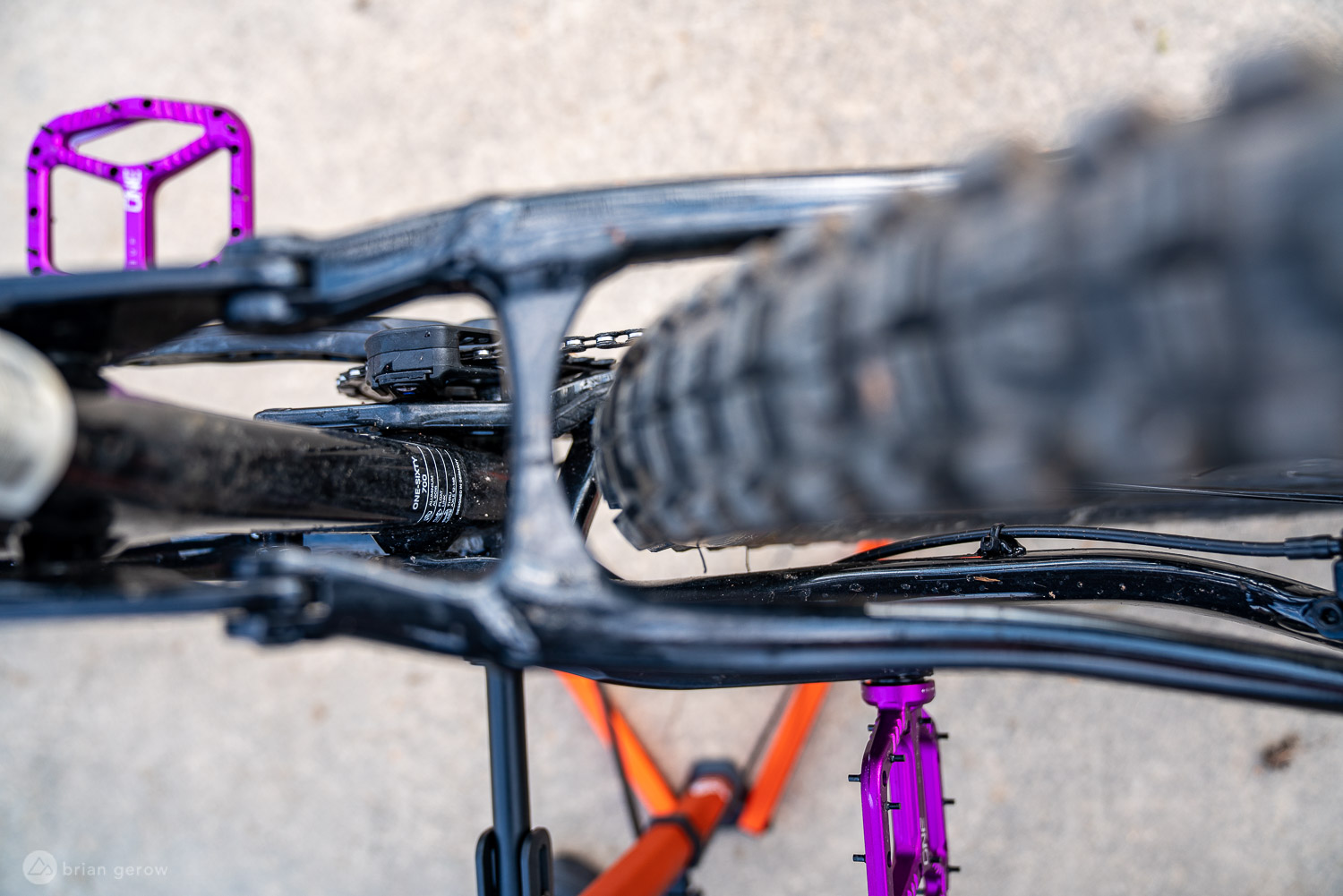
You might recall, five years or so ago, when World Cup XC announcers spent roughly 90% of the commentary debating wheel sizes. Now the diameter discussion has shifted to enduro and DH bikes, with most athletes selecting the big hoops or a mullet mix of the two. The largely science-free debate seems to have reached a fuzzy conclusion that 29ers are for racing and 27.5″ bikes are for playing. Nonetheless, plenty of enduro and DH racers are still lining up with midsize rubber on the ground, and Bryn Atkinson can throw tricks with the best of them on a 29er.
For 2020, Merida Bikes is offering a lineup of all-mountain and enduro sleds that favors the 27.5″ side of that debate. In fact, there are no 29ers in the lineup until their model’s travel squishes down to the 120mm mark. Given this level of confidence from one of the largest bike brands in the world, I was stoked to spend some time on their One-Sixty 700 enduro bike.
Who is the One-Sixty 700 designed for?

You’re likely here to answer this question, so I’ll get to it before digging into the details. For starters, it’s for someone who loves bikes with 27.5″ wheels. Some mid-diameter whips can feel like capable enduro plows, and the One-Sixty 700 is decidedly not one of them. Despite its 440mm reach and 165/170mm of travel, the bike felt noticeably small and agile. Its natural habitat is either on tight and twisty singletrack where precise handling is paramount or big-huck jump lines where the suspension will come in handy. If you are on the hunt for a long travel party bike I would recommend giving it a long look, but if it’s a throttle-open plow you seek you will likely want to order the bike in a size larger than usual to increase stability.
Build, geo, and frame spec

The One-Sixty enduro line is split into two carbon bikes and two alloy builds. The “700” build I tested is the top alloy model, priced at a reasonable €3,290. With a 12-speed Shimano XT drivetrain, SLX brakes, a Race Face Affect crankset, a RockShox Yari RC fork, and Superdeluxe Select+ shock, customers are getting a solid build for the price. Apart from the baller Maxxis Assegai and DHR tire selection with EXO+ casings, the build was largely made up of Merida’s “Expert TR” alloy house brand components. Much of the bike’s component selection seems spot on, and I will share more on that below.
The geometry table for the One-Sixty frame is generally on par with its peers. The size medium I rode has a short-ish 440mm reach and 430mm chainstays with a 65.3° headtube angle that stretches to a total 1189mm between the axles. I prefer to ride 27.5″ bikes with reach measurements longer than those of my 29er, but with a jump in seat tube length from 430mm to 470mm between the medium and large frames, I am confined to the medium. The 75° seat tube angle is certainly not extreme for a modern enduro bike, but given the frame’s moderate reach measurement things would likely start to feel cramped if it were any steeper.

Cutouts on either side of the seat tube provide even clamping force. 
There’s a multitool hidden under the saddle.
The 6066 series triple butted and hydroformed aluminum frame uses a carbon rocker arm to actuate its trunion mounted floating suspension design. According to Merida, the “‘Float Link’ rear end creates the feeling of almost bottomless travel whilst remaining perfectly controlled when climbing.” You’ll be able to see the Float Link in action in our coming video review of the bike. For now, the basic idea is this: it’s like a traditional four-bar trunion design, but the chainstay extends forward beyond the main lower pivot to hold the shock base and “float” with it throughout the travel.

The frame’s internal routing includes a series of clamps at the main entrance and exit ports, making for a genuinely quiet ride through the trees. Those same cable ports are Di2 approved, should you choose to electrify the bike. The shift cable and brake hose exit the frame beneath an equally internal BB92 bottom bracket.
Trail talk
Before I delve into the bike’s ride characteristics, I have two truths to disclose. First, I prefer 29ers, simply because I am accustomed to riding them. Outside of high-level racing, the wheel circumference debate is largely one of preference rather than superiority, and I prefer riding bikes that fit best with my style and my local tracks. Most days, those happen to roll on the big wheels. The second caveat is that I tested this bike with tubes in the tires. It arrived with tubes and no valves, tape, or sealant to make the conversion. I’m not keen on spending my personal pennies on test bikes, so I rode it as is. The tubes certainly affected the way the bike rides, so I wanted to drop that detail up front.
Pedaling toward the peak aboard the One-Sixty revealed a few standout characteristics. The RockShox Super Deluxe Select+ shock has a fairly light tune, and with 20% sag, the rear end bobbed considerably. Flipping the compression “threshold” switch did a good job to firm things up, and I followed that protocol on every ride thereafter. It’s important to note that this model of the Super Deluxe shock doesn’t include a slow or fast compression adjustment, and if you want to firm it up without over-inflating the shock (and sacrificing traction and overall travel) you will need to have it retuned or replaced. The brand’s 7000 series carbon fiber One-Sixty model does include a far more adjustable Fox Float X2 shock, but that bike’s price is nearly double that of the 700.

I have reached a happy place on the One-Sixty with roughly 18% sag to support the 165mm of rear travel, and 20% for the 170mm Yari that’s perched under the handlebar with a handfull of compression clicks and a few volume spacers inside. That’s less sag than I typically run in the winter, but again, the bike’s overall tune feels light. With that setup, the One-Sixty is a relatively spry little sprinter and it carries speed well through the turns. Though it doesn’t shine above the rest in any one area, it is a fun all-around bike to throw around my local tracks.

Wait, this bike’s raison d’être is descending, is it not? ‘Tis, so let’s get into it. Similar to the way that some bikes can feel lighter than the scale suggests, the One Sixty 700 feels smaller than its geo table suggests. Depending on how you ride, that sensation could be a benefit or a challenge. I found that the bike feels more twitchy than I like, and lacks stability on rougher terrain. It’s marketed as an enduro bike, but I would classify it further in the all-mountain category for its agile leanings and less plow-prone characteristics.
The frame’s scant 6mm of BB drop might have something to do with its somewhat more nervous descending character, and I can definitely say that I feel “on top of” the bike instead of “down in it” most of the time. For reference, the 27.5″ GT Force I tested last year had a 14mm drop while the Transition Patrol has a 15mm drop. This measurement is one area where 29″ bikes start to feel very different from their 27.5″ cousins. The BB center of Transition’s heavy-hitting Sentinel 29er is a full 30mm below the center of the hubs.
Closing thoughts
On two separate rides with friends I was told, “you’re riding slower today” and “it’s easier to keep up with you on that bike.” While speed isn’t the only reason I ride, this bike has not yet felt like one to fully let loose with. I have greatly enjoyed some long trail days on the One Sixty, but it’s simply not the right bike for my riding style. If you enjoy an uber active platform beneath your feet, this one might be just the ticket.
Finally, while the build is solid, I did have some trouble with the house brand dropper post running sluggishly in cold weather. The rest of the Expert TR house brand bits worked well, and seem built to last. The rims are particularly good looking, with a dialed 29mm internal width and just the right ratio of stiffness and flex where they need it. At nearly 15 kilos (33lbs) the One-Sixty 700 build holds a respectable weight for an enduro big squisher.

MSRP: €3290















1 Comments
Jan 23, 2020